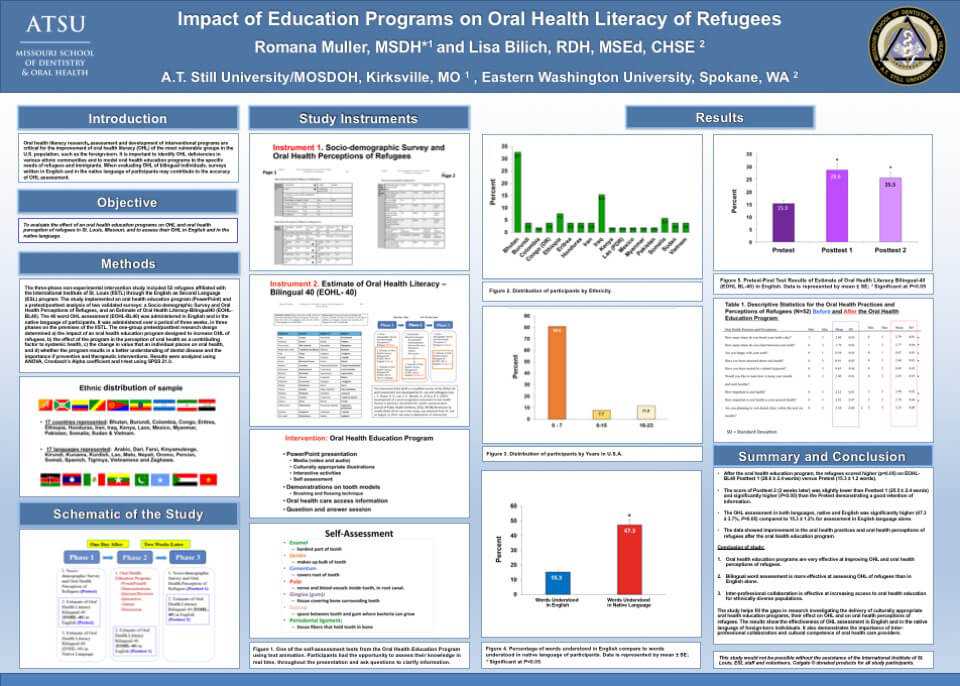Impact of Education Programs on Oral Health Literacy of Refugees
Contributors:
Romana Muller, MSDH
Lisa Bilich, RDH, MSEd, CHSE
Romana Muller, MSDH
Lisa Bilich, RDH, MSEd, CHSE
Participating Organizations:
A.T. Still University/MOSDOH, Kirksville, MO
Eastern Washington University, Spokane, WA
A.T. Still University/MOSDOH, Kirksville, MO
Eastern Washington University, Spokane, WA
Introduction
Oral health literacy research, assessment and development of interventional programs are critical for the improvement of oral health literacy (OHL) of the most vulnerable groups in the U.S. population, such as the foreign-born. It is important to identify OHL deficiencies in various ethnic communities and to model oral health education programs to the specific needs of refugees and immigrants. When evaluating OHL of bilingual individuals, surveys written in English and in the native language of participants may contribute to the accuracy of OHL assessment.
Oral health literacy research, assessment and development of interventional programs are critical for the improvement of oral health literacy (OHL) of the most vulnerable groups in the U.S. population, such as the foreign-born. It is important to identify OHL deficiencies in various ethnic communities and to model oral health education programs to the specific needs of refugees and immigrants. When evaluating OHL of bilingual individuals, surveys written in English and in the native language of participants may contribute to the accuracy of OHL assessment.
Objectives
To evaluate the effect of an oral health education programs on OHL and oral health perception of refugees in St. Louis, Missouri, and to assess their OHL in English and in the native language.
To evaluate the effect of an oral health education programs on OHL and oral health perception of refugees in St. Louis, Missouri, and to assess their OHL in English and in the native language.
Methods
The three-phase non-experimental intervention study included 52 refugees affiliated with the International Institute of St. Louis (IISTL) through the English as Second Language (ESL) program. The study implemented an oral health education program (PowerPoint) and a pretest/posttest analysis of two validated surveys: a Socio-demographic Survey and Oral Health Perceptions of Refugees, and an Estimate of Oral Health Literacy-Bilingual40 (EOHL-BL40). The 40 word OHL assessment (EOHL-BL40) was administered in English and in the native language of participants. It was administered over a period of three weeks, in three phases on the premises of the IISTL. The one-group pretest/posttest research design determined a) the impact of an oral health education program designed to increase OHL of refugees, b) the effect of the program in the perception of oral health as a contributing factor to systemic health, c) the change in value that an individual places on oral health, and d) whether the program results in a better understanding of dental disease and the importance if preventive and therapeutic interventions. Results were analyzed using ANOVA, Cronbach’s Alpha coefficient and t-test using SPSS 21.0.
The three-phase non-experimental intervention study included 52 refugees affiliated with the International Institute of St. Louis (IISTL) through the English as Second Language (ESL) program. The study implemented an oral health education program (PowerPoint) and a pretest/posttest analysis of two validated surveys: a Socio-demographic Survey and Oral Health Perceptions of Refugees, and an Estimate of Oral Health Literacy-Bilingual40 (EOHL-BL40). The 40 word OHL assessment (EOHL-BL40) was administered in English and in the native language of participants. It was administered over a period of three weeks, in three phases on the premises of the IISTL. The one-group pretest/posttest research design determined a) the impact of an oral health education program designed to increase OHL of refugees, b) the effect of the program in the perception of oral health as a contributing factor to systemic health, c) the change in value that an individual places on oral health, and d) whether the program results in a better understanding of dental disease and the importance if preventive and therapeutic interventions. Results were analyzed using ANOVA, Cronbach’s Alpha coefficient and t-test using SPSS 21.0.
